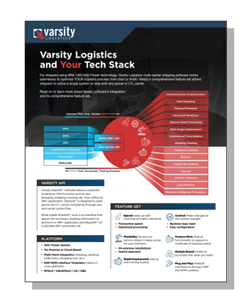
4 Key Characteristics of an A+ Multi-Carrier Shipping Solution for IBM i Users
Discover the top 4 must-haves for shippers seeking a reliable multi-carrier shipping solution
The modern shipping landscape has been met with many complexities, ranging from heightened customer expectations to constant pressures to reduce costs and improve service levels. The shipping industry is highly cutthroat, making it essential for businesses to navigate these complexities with agility and efficiency. For IBM i (AS/400) Power shippers, integrating advanced shipping solutions within their existing infrastructure is crucial for maintaining operational advantages and staying competitive.
However, while choosing the right shipping software is critical for success, it is also a difficult task. Identifying all the features your business not only wants, but also needs from your multi-carrier shipping software can be a challenge. To help key decision makers pinpoint a shipping solution that will set their business up for long-term success, we’ve identified the top 4 must-have characteristics to look for in your parcel and less-than-truckload (LTL) multi-carrier shipping software (MCSS).
1. Carrier Versatility and Adaptability
A multi-carrier shipping solution that offers service versatility and adaptability is a crucial advantage for parcel and LTL shippers. By offering access to a diverse variety of carriers, it mitigates the risk of disruptions that can potentially occur if a primary carrier faces unforeseen circumstances. The ability to adapt to shifting industry environments by utilizing a library of diversified carriers ensures shippers can maintain consistent delivery performance.
Additionally, carriers offer many varieties of strengths they provide in terms of geographic coverage, delivery speed, and specialized services. Maintaining a diversified carrier network enables shippers the versatility to utilize the best carrier option based on specific shipment needs. It also ensures consistent delivery performance and optimized service levels across different regions and service requirements. Overall, carrier versatility and adaptability not only enhance your business’ performance but also improves customer satisfaction. [Explore the 7 Benefits of Carrier Diversification.]
How does Varsity Logistics achieve this?
With Varsity Logistics, shippers can seamlessly process packages with any carrier of choice, including FedEx, UPS, USPS, DHL, Purolator, OnTrac, Spee-Dee, and more. All carrier software is fully integrated into the IBM i system, allowing parcel and LTL shippers to manage shipments using a single printer and scale, regardless of the carrier. This integration ensures that your business isn’t held hostage by any single carrier’s terms and equipment, giving you the freedom to select the best carrier based on service quality, cost, and convenience.
Furthermore, Varsity’s solution allows shippers to switch between parcel and LTL carriers as needed and compare rates effortlessly. This comprehensive capability ensures you can adapt to changing shipping requirements without disrupting your operations, optimizing your shipping strategy for both cost-effectiveness and reliability.
2. Operational Independence and Flexibility
Operational independence and flexibility are important characteristics of your multi-carrier shipping software when operating in a dynamic shipping environment. These qualities allow businesses to manage their operations autonomously, without being tied down by the constraints of a single carrier’s terms and system. It empowers shippers to adapt to changing market conditions, peak season fluctuations, and evolving customer demands freely.
Successful shippers utilize MCSS solutions that provide the ability to customize workflows, integrate with various platforms, and switch carriers effortlessly, ensuring they’re always opting for the most efficient, cost-effective, and reliable shipping options available at any given time. The flexibility that operational independence produces is critical for shippers to maintain their competitive edge, high service standards, and customer satisfaction.
How does Varsity Logistics achieve this?
Varsity’s industry leading multi-carrier shipping software achieves both operational independence and significant flexibility for IBM i (AS/400) Power users. The ability to integrate with all major parcel carriers and a variety of LTL freight providers allows businesses to switch carriers whenever convenient without being hit with the frustrating roadblocks, high costs, or other limitations associated with being tied to a single carrier. With Varsity, you gain the freedom to leverage a network of supported carriers. This allows you to seamlessly switch between these integrated carriers based on factors like product, location, season, or price.
Varsity’s software allows customizable workflows tailored to each business’ unique needs and requirements, from order processing to label generation and reporting. It also supports integration with all major IBM i enterprise resource planning (ERP) systems and warehouse management systems (WMS). By being ERP and WMS technology agnostic, Varsity’s shipping solutions enable seamless data exchange across various platforms, ensuring that businesses are not restricted by specific technologies. This flexibility is crucial for companies looking to streamline operations without being tied to a particular system.
By remaining untethered from individual carrier platforms, Varsity enhances operational efficiency through a centralized approach, offering greater visibility and control over the entire shipping process. This independence allows businesses to swiftly adapt to changes and optimize workflows according to their preferred methods. Whether managing order processing, label generation, or reporting, Varsity’s adaptable solution integrates seamlessly with your existing ERP and WMS systems. This approach not only improves data flow but also empowers businesses to maintain high levels of efficiency and responsiveness in a dynamic shipping environment. [Learn more about Varsity’s tech partners.]
3. Significant Cost Savings and Negotiation Power
When evaluating the best multi-carrier shipping solution for your business, it is important that you consider something that will not only produce an ROI, but also provide opportunities for significant cost savings and negotiation power. It is common knowledge that shipping costs represent a substantial piece of the operational costs that businesses incur, so any opportunity to minimize them can largely impact a company’s profitability and competitiveness.
Top MCSS solutions provide the flexibility to choose between multiple carriers, enabling shippers to steer clear of restrictive carrier terms. This allows businesses the ability to negotiate better rates and service conditions, ultimately enhancing their bargaining power. Having this negotiation power opens the door to the advantages of promotions, discounts, or improved service offerings by competing carriers which can lead to significant cost savings and an optimized logistics budget.
Another area for significant cost savings with your shipping software is shipment containerization functionalities. Shipment containerization allows businesses to combine several shipments into a single shipping container. Doing so reduces the costs of labor, such as loading and unloading, as well as the per-unit shipping cost due to efficient container stacking and packing of goods. This process optimizes carton volume, eliminating wasted space, reduces the risk of damage and theft, and improves overall operational efficiency.
How does Varsity Logistics achieve this?
Achieving cost savings and enhanced negotiation power is an area where Varsity Logistics excels through our multi-carrier solution for IBM i (AS/400) shippers. Businesses can seamlessly manage multiple parcel and LTL carriers from a single, unified platform, enabling them to adjust carriers based on specific shipment needs or market conditions. By not being tied to a single carrier, shippers can switch carriers to negotiate better rates and delivery terms, using the most effective and cost-efficient options. Varsity also eliminates hidden costs associated with carrier changes, facilitating smooth transitions without additional hardware, software, or extensive training. This puts businesses in control of negotiating prices, enabling them to adapt quickly to changing rates and secure deeper discounts, typically ranging from 5-10% on freight expenditures.
Additional cost savings can be achieved with Varsity’s solution through our ShipOptimizer module – a comprehensive containerization tool empowering businesses to conquer the obstacles of packing consumer goods both efficiently and cost-effectively. By accurately predicting shipping costs at the time an order is placed, ShipOptimizer gives businesses an efficient plan to build cartons, pallets, and trailers with the size and number of cartons needed. This automated process empowers shippers to handle increasingly complex processing requirements with ease while also producing significant savings on your business’ shipping costs. [Explore optimizing parcel packing with containerization.]
4. Enhanced Resilience and Reliability
The modern world of logistics is filled with complexities, volatility, and the lingering unknown. This reality makes resilience and reliability pivotal characteristics for shippers navigating the industry. Adopting a multi-carrier approach enhances operational resilience for IBM i (AS/400) Power systems shippers by mitigating the impact of potential disruptions and ensuring operational continuity, even in the most turbulent times. [Dive into 5 ways shipping software helps you master market volatility.]
A critical way industry-leading MCSS solutions provide resilience and reliability is through proactive monitoring and alert tools. These capabilities can continuously track current carrier performance, giving shippers important insights into shipment statuses and carrier operations. Most importantly, it empowers shippers to take preemptive actions against potential issues before they escalate. This proactive approach helps minimize delays and ensures reliable delivery timelines, thereby enhancing customer satisfaction and loyalty.
Retrieving and effectively preserving shipping data can be a large hurdle when it comes to obtaining valuable decision-support information. Additionally, we often see instances where historical data is either stored inconsistently or not at all. However, historical data and advanced analytics are key functionalities for shippers to identify important trends, analyze carrier performance over time, and make informed decisions. Advanced multi-carrier systems provide streamlined access to important analytics and historical data to help bring visibility to their supply chains, giving shippers leverage to make data-driven decisions, mitigate risks, and adapt quickly to industry changes.
How does Varsity Logistics achieve this?
Operational continuity and meeting customer demands is paramount, as industry disruptions and unforeseen events can severely impact supply chains and customer satisfaction. Varsity recognizes the importance of and is committed to providing resilience and reliability to shippers, empowering them to weather unexpected challenges.
One way Varsity accomplishes this is with the capabilities of our parcel shipping suite where we offer a valuable supply chain execution module, ShipTalk. This transformative tool provides real-time access to order status, tracking, and tracing. It also utilizes a proactive approach, providing alerts containing specific shipment details at any point throughout the shipment process. This end-to-end visibility enables businesses to monitor shipments and take necessary action if something were to arise. [Discover the vital role of real-time parcel tracking.]
Historical data and analytics are also a critical capability of Varsity’s top-tier solution. For both parcel and less-than-truckload (LTL) shippers, Varsity’s Transdata datamart gives businesses readily accessible, organized, and highly detailed historical data and analytics. This valuable information enhances resilience and reliability for shippers by enabling proactive risk identification, helping identify bottlenecks and inefficiencies to let shippers know when to adjust their shipping strategies. [Learn more about analytics for smarter shipping on IBM i].
Why Make the Switch to Varsity Logistics
Varsity Logistics stands proudly as the only holistic shipping solution built for shippers on IBM i (AS/400) Power systems. Whether you’re shipping parcel or freight, Varsity provides shippers with significant advantages in navigating the complexities of the modern shipping landscape. This comprehensive multi-carrier shipping software solution integrates with a wide variety of carriers, eliminating dependence on any single carrier and the baggage that comes with it. It empowers operational automatization and the flexibility to customize workflows and integrations to your specific requirements. Varsity provides unmatched negotiation power and savings on your bottom line; something you could never do with commitment to a single carrier. And while this holistic multi-carrier solution provides all these crucial and beneficial things for IBM i shippers, it protects businesses from disruptions and volatility at the same time.
Varsity’s shipping solution is industry leading for a reason; it has the comprehensive functionality businesses can leverage to optimize, streamline, protect, and grow their operations in one place. Varsity Logistics is not only committed to enhancing your overall efficiency, but also strives to support your long-term growth and profitability. Are you ready to explore how Varsity’s A+ solution can revolutionize your business? Contact our team of shipping experts or schedule a pressure-free demo today. The only holistic shipping solution built for the IBM i.















